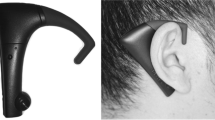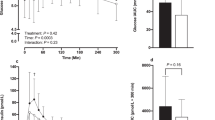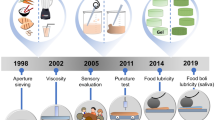Abstract
Objectives:
To investigate the effects of appetitive sensations, body mass index (BMI) and physical/sensory properties of food (almonds) on masticatory indices and resultant pre-swallowing particle sizes.
Subjects/Methods:
Twelve lean (BMI=22.2±0.3) and 12 obese (BMI=34.3±0.6) adults. After collecting appetitive ratings, electromyographic recordings were used to assess participants’ microstructure of eating for five almond products (raw, dry unsalted roasted, natural sliced, roasted salted and honey roasted) under fasted and satiated conditions. Duplicate samples were masticated to the point of deglutition and then were expectorated and size sorted.
Results:
No statistically significant effects of BMI were detected for any of the mastication measures. Maximum and mean bite forces were greater under the fasted condition. Sliced almonds required lower bite force than did the other almond varieties. The pre-swallowing particle sizes were significantly greater for the sliced almonds than all other varieties. Both the number of chews and mastication time were negatively correlated with particle size. There were no significant effects of almond form or flavor on particle size.
Conclusions:
These results do not support differences in masticatory performance between lean and obese individuals, nor effects of sensory properties. Instead, the physical form of foods as well as an individuals’ appetitive state may have a greater influence on masticatory behavior. The health implications of these observations warrant further investigation.
This is a preview of subscription content, access via your institution
Access options
Subscribe to this journal
Receive 12 print issues and online access
$259.00 per year
only $21.58 per issue
Buy this article
- Purchase on Springer Link
- Instant access to full article PDF
Prices may be subject to local taxes which are calculated during checkout

Similar content being viewed by others
References
Arosio M, Ronchi CL, Beck-Peccoz P, Gebbia C, Giavoli C, Cappiello V et al. (2004). Effects of modified sham feeding on ghrelin levels in healthy human subjects. J Clin Endocrinol Metab 89, 5101–5104.
Bellisle F, Le Magnen J (1981). The structure of meals in humans: eating and drinking patterns in lean and obese subjects. Physiol Behav 27, 649–658.
Bellisle F, Lucas F, Amrani R, Le Magnen J (1984). Deprivation, palatability and the micro-structure of meals in human subjects. Appetite 5, 85–94.
Bruce DG, Storlien LH, Furler SM, Chisholm DJ (1987). Cephalic phase metabolic responses in normal weight adults. Metabolism 36, 721–725.
Burton-Freeman B, Davis PA, Schneeman BO (2002). Plasma cholecystokinin is associated with subjective measures of satiety in women. Am J Clin Nutr 76, 659–667.
Burton-Freeman B, Davis PA, Schneeman BO (2004). Interaction of fat availability and sex on postprandial satiety and cholecystokinin after mixed-food meals. Am J Clin Nutr 80, 1207–1214.
Coelho SB, de Sales RL, Iyer SS, Bressan J, Costa NM, Lokko P et al. (2006). Effects of peanut oil load on energy expenditure, body composition, lipid profile, and appetite in lean and overweight adults. Nutrition 22, 585–592.
Ellis PR, Kendall CW, Ren Y, Parker C, Pacy JF, Waldron KW et al. (2004). Role of cell walls in the bioaccessibility of lipids in almond seeds. Am J Clin Nutr 80, 604–613.
Feinle C, O'Donovan D, Doran S, Andrews JM, Wishart J, Chapman I et al. (2003). Effects of fat digestion on appetite, APD motility, and gut hormones in response to duodenal fat infusion in humans. Am J Physiol Gastrointest Liver Physiol 284, G798–G807.
Feltrin KL, Little TJ, Meyer JH, Horowitz M, Smout AJ, Wishart J et al. (2004). Effects of intraduodenal fatty acids on appetite, antropyloroduodenal motility, and plasma CCK and GLP-1 in humans vary with their chain length. Am J Physiol Regul Integr Comp Physiol 287, R524–R533.
Fontijn-Tekamp FA, van der Bilt A, Abbink JH, Bosman F (2004). Swallowing threshold and masticatory performance in dentate adults. Physiol Behav 83, 431–436.
Fraser GE, Bennett HW, Jaceldo KB, Sabate J (2002). Effect on body weight of a free 76 kilojoule (320 calorie) daily supplement of almonds for six months. J Am Coll Nutr 21, 275–283.
Fukagawa K, Sakata T, Shiraishi T, Yoshimatsu H, Fujimoto K, Ookuma K et al. (1989). Neuronal histamine modulates feeding behavior through H1-receptor in rat hypothalamus. Am J Physiol 256, R605–R611.
Hiiemae K, Heath MR, Heath G, Kazazoglu E, Murray J, Sapper D et al. (1996). Natural bites, food consistency and feeding behaviour in man. Arch Oral Biol 41, 175–189.
Hiiemae KM, Palmer JB (1999). Food transport and bolus formation during complete feeding sequences on foods of different initial consistency (see comment). Dysphagia 14, 31–42.
Hill SW, McCutcheon NB (1984). Contributions of obesity, gender, hunger, food preference, and body size to bite size, bite speed, and rate of eating. Appetite 5, 73–83.
Hollis JH, Mattes RD : Does adding a high fat, high energy density food to one's diet necessarily promote weight gain. Br J Nutr (in press).
Jenkins DJ, Kendall CW, Marchie A, Parker TL, Connelly PW, Qian W et al. (2002). Dose response of almonds on coronary heart disease risk factors: blood lipids, oxidized low-density lipoproteins, lipoprotein(a), homocysteine, and pulmonary nitric oxide: a randomized, controlled, crossover trial. Circulation 106, 1327–1332.
Jordan HA (1969). Voluntary intragastric feeding: oral and gastric contributions to food intake and hunger in man. J Comp Physiol Psychol 68, 498–506.
Lavin JH, French SJ, Read NW (2002). Comparison of oral and gastric administration of sucrose and maltose on gastric emptying rate and appetite. Int J Obes Relat Metab Disord 26, 80–86.
le Roux CW, Batterham RL, Aylwin SJ, Patterson M, Borg CM, Wynne KJ et al. (2006). Attenuated peptide YY release in obese subjects is associated with reduced satiety. Endocrinology 147, 3–8.
Lucas PW, Luke DA (1983). Methods for analysing the breakdown of food in human mastication. Arch Oral Biol 28, 813–819.
Lucas PW, Luke DA (1984). Optimum mouthful for food comminution in human mastication. Arch Oral Biol 29, 205–210.
Lucas PW, Luke DA (1986). Is food particle size a criterion for the initiation of swallowing? J Oral Rehabil 13, 127–136.
Mioche L, Bourdiol P, Monier S, Martin JF, Cormier D (2004). Changes in jaw muscles activity with age: effects on food bolus properties. Physiol Behav 82, 621–627.
Naslund E, Barkeling B, King N, Gutniak M, Blundell JE, Holst JJ et al. (1999). Energy intake and appetite are suppressed by glucagon-like peptide-1 (GLP-1) in obese men. Int J Obes Relat Metab Disord 23, 304–311.
Ookuma K, Sakata T, Fukagawa K, Yoshimatsu H, Kurokawa M, Machidori H et al. (1993). Neuronal histamine in the hypothalamus suppresses food intake in rats. Brain Res 628, 235–242.
Ookuma K, Yoshimatsu H, Sakata T, Fujimoto K, Fukagawa F (1989). Hypothalamic sites of neuronal histamine action on food intake by rats. Brain Res 490, 268–275.
Ow RK, Carlsson GE, Karlsson S (1998). Relationship of masticatory mandibular movements to masticatory performance of dentate adults: a method study. J Oral Rehabil 25, 821–829.
Peyron MA, Mishellany A, Woda A (2004). Particle size distribution of food boluses after mastication of six natural foods. J Dent Res 83, 578–582.
Prinz JF, Lucas PW (1995). Swallow thresholds in human mastication. Arch Oral Biol 40, 401–403.
Richardson CT, Feldman M (1986). Salivary response to food in humans and its effect on gastric acid secretion. Am J Physiol 250, G85–G91.
Sabate J, Haddad E, Tanzman JS, Jambazian P, Rajaram S (2003). Serum lipid response to the graduated enrichment of a step I diet with almonds: a randomized feeding trial. Am J Clin Nutr 77, 1379–1384.
Sakata T (1995). Histamine receptor and its regulation of energy metabolism. Obes Res 3 (Suppl 4), 541S–548S.
Sakata T, Fukagawa K, Fujimoto K, Yoshimatsu H, Shiraishi T, Wada H (1988a). Feeding induced by blockade of histamine H1-receptor in rat brain. Experientia 44, 216–218.
Sakata T, Ookuma K, Fukagawa K, Fujimoto K, Yoshimatsu H, Shiraishi T et al. (1988b). Blockade of the histamine H1-receptor in the rat ventromedial hypothalamus and feeding elicitation. Brain Res 441, 403–407.
Sakata T, Yoshimatsu H, Masaki T, Tsuda K (2003). Anti-obesity actions of mastication driven by histamine neurons in rats. Exp Biol Med (Maywood) 228, 1106–1110.
Schafmayer A, Nustede R, Pompino A, Kohler H (1988). Vagal influence on cholecystokinin and neurotensin release in conscious dogs. Scand J Gastroenterol 23, 315–320.
Schulz M, Kroke A, Liese AD, Hoffmann K, Bergmann MM, Boeing H (2002). Food groups as predictors for short-term weight changes in men and women of the EPIC-Potsdam cohort. J Nutr 132, 1335–1340.
Sobhani I, Buyse M, Goiot H, Weber N, Laigneau JP, Henin D et al. (2002). Vagal stimulation rapidly increases leptin secretion in human stomach. Gastroenterology 122, 259–263.
Spiegel TA (2000). Rate of intake, bites, and chews-the interpretation of lean–obese differences. Neurosci Biobehav Rev 24, 229–237.
Spiegel TA, Kaplan JM, Tomassini A, Stellar E (1993). Bite size, ingestion rate, and meal size in lean and obese women. Appetite 21, 131–145.
Spiegel TA, Shrager EE, Stellar E (1989). Responses of lean and obese subjects to preloads, deprivation, and palatability. Appetite 13, 45–69.
Spiller GA, Jenkins DA, Bosello O, Gates JE, Cragen LN, Bruce B (1998). Nuts and plasma lipids: an almond-based diet lowers LDL-C while preserving HDL-C. J Am Coll Nutr 17, 285–290.
Stunkard AJ, Messick S (1985). The three-factor eating questionnaire to measure dietary restraint, disinhibition and hunger. J Psychosom Res 29, 71–83.
Teff KL, Devine J, Engelman K (1995). Sweet taste: effect on cephalic phase insulin release in men. Physiol Behav 57, 1089–1095.
Teff KL, Engelman K (1996). Palatability and dietary restraint: effect on cephalic phase insulin release in women. Physiol Behav 60, 567–573.
Teff KL, Mattes RD, Engelman K (1991). Cephalic phase insulin release in normal weight males: verification and reliability. Am J Physiol 261, E430–E436.
Wisen O, Bjorvell H, Cantor P, Johansson C, Theodorsson E (1992). Plasma concentrations of regulatory peptides in obesity following modified sham feeding (MSF) and a liquid test meal. Regul Pept 39, 43–54.
Yeomans MR, Blundell JE, Leshem M (2004). Palatability: response to nutritional need or need-free stimulation of appetite? Br J Nutr 92 (Suppl 1), S3–S14.
Acknowledgements
This study was supported by a grant from the Almond Board of California.
Author information
Authors and Affiliations
Corresponding author
Additional information
Contributors: All three authors contributed to developing the concept and protocol of the study. JMF recruited and ran all participants. All three authors contributed to the preparation of the manuscript as well as data analyses.
Rights and permissions
About this article
Cite this article
Frecka, J., Hollis, J. & Mattes, R. Effects of appetite, BMI, food form and flavor on mastication: almonds as a test food. Eur J Clin Nutr 62, 1231–1238 (2008). https://doi.org/10.1038/sj.ejcn.1602838
Received:
Revised:
Accepted:
Published:
Issue Date:
DOI: https://doi.org/10.1038/sj.ejcn.1602838
Keywords
This article is cited by
-
Association of mastication and factors affecting masticatory function with obesity in adults: a systematic review
BMC Oral Health (2018)
-
Do dry roasting, lightly salting nuts affect their cardioprotective properties and acceptability?
European Journal of Nutrition (2017)
-
Nut-enriched bread is an effective and acceptable vehicle to improve regular nut consumption
European Journal of Nutrition (2016)
-
The relationship between nut consumption and lipid profile among the Iranian adult population; Isfahan Healthy Heart Program
European Journal of Clinical Nutrition (2013)
-
Effects of different forms of hazelnuts on blood lipids and α-tocopherol concentrations in mildly hypercholesterolemic individuals
European Journal of Clinical Nutrition (2011)



